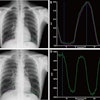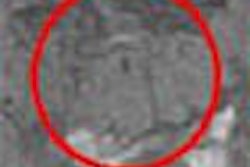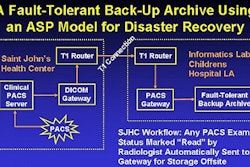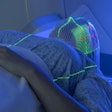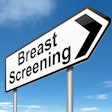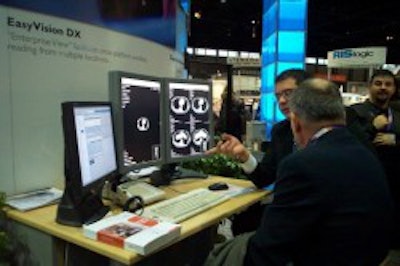
If one had to find a theme for the 2002 Radiological Society of North America meeting, Return to Normalcy might be a good one. All but gone were concerns over terrorism that clouded the 2001 conference and led to a double-digit decline in attendance that year, especially among international visitors.
RSNA officials said the 2002 show recovered almost completely from the attendance drop it suffered the year before, with attendance only slightly below 2000 levels. Total attendance was up 11% compared to 2001, and was down 2% compared with the 2000 meeting.
 |
|
The Chicago skyline during RSNA 2002.
|
The conference also highlighted radiology's continuing technological growth and evolution. Major advances were seen in clinical presentations on PET/CT fusion imaging, advanced multislice CT applications, and full-field digital mammography. Computer-aided detection made solid gains outside its core niche in mammography, while the vigorous debate over CT screening generated headlines.
There were few show-stopping announcements on the technical exhibit floor. In fact, some industry observers believe that the market could be entering a period of slower technological evolution as vendors digest recent acquisitions and as technologies introduced at past meetings, like PET/CT and digital radiography, slowly permeate the market.
The following is a rundown of some of the clinical highlights from the 2002 meeting.
Full-field digital mammography
Full-field digital mammography (FFDM) continues to produce a growing volume of clinical research. A Norwegian study showed that FFDM compares favorably to conventional analog screening mammography in detecting cancer. In women ages 50-69, soft-copy reading of FFDM exams showed a slightly higher cancer detection rate than film-screen mammography, the researchers concluded. In women ages 45-49, the two methods were comparable, which the researchers said makes FFDM with soft-copy reading suitable for breast cancer screening.
FFDM may also have an edge over conventional mammography in radiation dose, according to German researchers who compared the two techniques and found they could reduce radiation exposure with FFDM by as much as one-fourth. Meanwhile, an Austrian group achieved dose reductions of at least 50% when using FFDM to verify the placement of clips or wire markers.
In a related mammography study, U.S. researchers found that calcified breast arteries on a mammogram may be linked to a woman’s risk of heart disease. They found a 20% increase in risk of heart disease among women with breast calcifications -- that’s low compared to the increased risk caused by diabetes or high blood pressure (110%) or high cholesterol (80%), but it’s significant enough to be worth noting, the researchers said.
Computer-aided detection
Computer-aided detection (CAD) systems are another new technology that is changing mammography. One RSNA study, by U.S. researchers, compared the performance of the three major CAD workstations, from R2 Technology of Sunnyvale, CA; iCAD of Boca Raton, FL; and CADx Systems of Beavercreek, OH. While the group found subtle differences in performance between systems, they stated that all three did a good job of helping radiologists detect cancer.
Another study, by another U.S. group, found that adding CAD as a second reader to a mammography screening program led to a slight (2%) increase in recalls, but the system increased the cancer detection rate by 7%.
On the vendor side, CAD developers are beginning to branch out from mammography to develop CAD algorithms that analyze other types of images, such as chest x-rays or virtual colonoscopy images.
 |
|
RSNA officials reported 11% attendance growth at the 2002 meeting.
|
In lung CAD, when a U.S. group pitted man against machine, the machine won. Three experienced radiologists achieved a mean 79% sensitivity for the detection of lung nodules. The CAD scheme delivered up to 96% sensitivity, although with significantly more false-positive results. Another lung CAD system was found to save time and increase sensitivity significantly in follow-up studies of patients who had been screened previously. The system worked by comparing nodules detected in the initial examination to nodules seen in follow-up scans, and quickly determined if any had grown in size.
CAD proponents are counting on the technology to eventually become commonplace for a wide range of imaging studies, helping overtaxed radiologists cope with rising workloads.
Fusion PET/CT
Clinical results are starting to stream in from sites using the new fusion PET/CT scanners. Researchers are finding that the fused anatomical and functional data collected with the systems are helpful in detecting a wide range of cancers. One group found that PET/CT helped them reduce equivocal readings by 53%, while another researcher found the technology invaluable for surgical and radiation therapy planning by guiding treatment to exactly the right location.
U.S. researchers claimed that PET/CT is the modality of choice for detecting ovarian cancer. And a German group reported that even though some cancers can be seen better on MRI, they would prefer to use PET/CT to stage tumors. PET/CT proved superior in detecting lymph node metastases and pulmonary metastases, while MRI was able to more accurately assess bone metastases. In the final analysis, the modalities are complementary when staging disease, the researchers concluded.
On the instrumentation side, several vendors upgraded their PET/CT fusion scanners by showing new systems featuring state-of-the-art 16-slice scanners. Some firms are also exploring new crystal materials, such as lutetium oxyorthosilicate (LSO) and gadolinium oxyorthosilicate (GSO), to increase the throughput of the scanners and make it more cost-effective for imaging facilities to operate them.
CT screening
Whole-body CT screening was one of most controversial topics of the conference. A number of RSNA presentations addressed this phenomenon, with one study concluding that because the scans didn’t use contrast, they weren’t effective for detecting conditions such as kidney, liver, or stomach cancer. At the least, full-body exams should be limited to patients older than 45, the researchers recommended, as the risk/benefit ratio simply isn’t high enough for younger patients.
However, efforts to restrict the procedure are bound to clash with the high level of interest potential customers have shown in the procedure. One survey found that among people who initially had no opinion on CT screening, 82% became interested in the procedure after it was described to them. Many people are seeking out screening because of an interest in their own health and their desire to make lifestyle changes, the researchers found.
In other CT-related presentations, Dutch researchers found a strong association between CT-detected coronary calcium and mortality. More than 2,000 patients were scanned with an electron-beam CT scanner, and the researchers found the death rate skewed convincingly toward those with the highest calcium scores. Patients with the highest scores had 2.7 times the risk of death compared with those scoring lowest.
Meanwhile, a Canadian group demonstrated that CT screening for lung cancer can be improved significantly by adding computer-aided sputum cytology to the screening protocol. Sputum cytology helped identify those smokers at higher risk for lung cancer, and among this group of 423 patients, there were 13 patients with primary lung cancers; in 138 patients with normal sputum results, no cancers were found.
Finally, a German group presented research on optimizing protocols for coronary artery calcium scanning with a 16-slice system. They found that 3-mm slice widths and thin, submillimeter (0.75 mm) collimation enabled the detection of smaller calcium deposits. Scan times and radiation dose were slightly higher, but radiologists using the wider collimation (1.5 mm) were unable to visualize the smallest detectable lesions, the presenter said.
Virtual colonoscopy
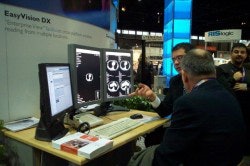 |
|
Vendors reported healthy traffic on the technical exhibit floor.
|
Another relatively new technology is virtual colonoscopy, and several RSNA presentations demonstrated the inroads CT colonography is making in the clinical realm. In one study, Japanese researchers using a 16-slice CT scanner demonstrated that virtual colonoscopy detected hard-to-find flat lesions just as well as conventional colonoscopy.
A U.S. study compared detection rates of virtual colonoscopy to conventional colonoscopy in a screening population, rather than in the high-risk populations used for earlier studies. The researchers found that while virtual colonoscopy did well for polyps 10 mm and larger, its performance declined for smaller polyps. The results raise thorny questions regarding how radiologists should handle the reporting of smaller lesions, the researchers said.
Finally, a German group that has conducted research into MR-based virtual colonoscopy presented its latest work on optimizing the studies with a fecal-tagging technique that uses a barium sulfate preparation to darken residual stool in the colon to the same MRI signal intensity as the rectal barium enema that is applied before imaging. This makes it easier to visualize polyps, which have a higher signal intensity on scans.
MRI highlights
U.S. investigators discussed their work in devising a new MR protocol for imaging cartilage of the knee using a 3-point Dixon gradient-echo sequence. Their method compensates for the limited separation of fat and water peaks that generally hampers low-field MR imaging.
Italian researchers found that adding MRI to the pre-treatment workup of patients with Crohn’s disease offers important information on the activity and extent of the digestive illness, as well as possible complications that may require surgery. All of the MR criteria the radiologists used to evaluate the images strongly correlated with the clinical and biological signs of active Crohn’s disease, the researchers reported.
The slow progression of West Nile Virus across the U.S. grabbed headlines in 2002, and one RSNA study employed MRI to assess patients known to have the disease. They found that MRI might not be a good first-line tool for diagnosis: Researchers found that extensive disease may be present in patients with West Nile Virus encephalitis before it can be seen in MRI. The modality is still very useful for ruling out the presence of other neurologic disease with overlapping symptoms, they said.
In another study, U.S. researchers developed a method for noninvasively staging prostate cancer using proton magnetic resonance spectroscopy. The technique analyzed choline, creatine, and citrate, and correlated the presence of these substances to Gleason scores, a common method of grading the appearance of prostate cancer tissue.
French researchers described their work on a technique that used MR scanning for virtual endoscopy of the biliary tract. They found it to be more effective than maximum intensity projection (MIP) MR for identifying small stones of 3 mm or more.
Finally, a Canadian team discussed its use of MRI to stage non-Hodgkin’s lymphoma in pediatric patients. Preliminary results are encouraging, and suggest that whole-body MRI may replace standard radiographic procedures for the staging and follow-up of NHL in children. The team is seeking to conduct further studies to determine accuracy and develop additional protocols.
By Brian Casey
AuntMinnie.com staff writer
January 22, 2003
Copyright © 2003 AuntMinnie.com



